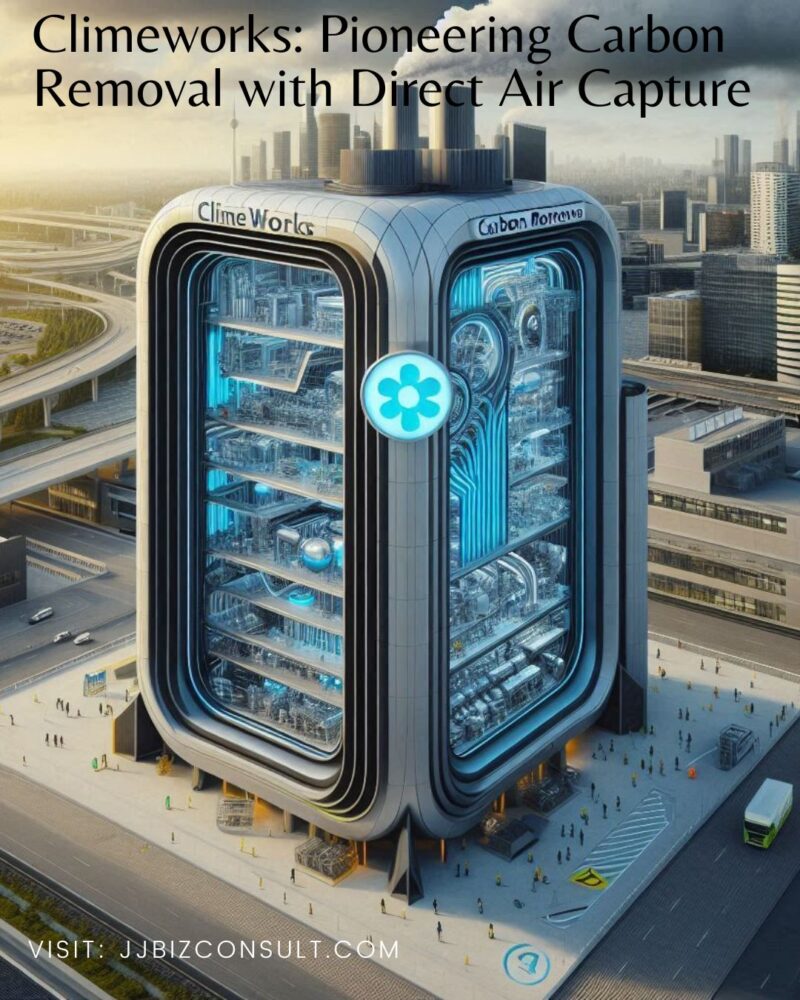Climeworks: Pioneering Carbon Removal with Direct Air Capture

Climeworks, a company dedicated to tackling climate change through carbon removal solutions, has taken a giant leap forward with the unveiling of Mammoth – the world’s largest direct air capture (DAC) facility. This innovative project marks a significant milestone in the fight against global warming and has the potential to revolutionize how we address atmospheric CO2 levels.
The Mammoth Climeworks Project

- Climeworks has set up what can only be described as a giant “vacuum cleaner” in Iceland. The Mammoth project is designed to remove an impressive 36,000 metric tons of emissions annually from the atmosphere .
- The project utilizes direct air capture (DAC) technology, which involves collecting CO₂ from ambient air using specialized filters. These filters then trap the carbon, preventing it from contributing to global warming .
- The Mammoth project is currently two years into construction and is already ten times more effective than previous efforts by Climeworks . It operates with a total of 72 air scrubbers, although only 12 are currently active.
- Climeworks aims to scale up its carbon removal capacity significantly. By 2030, they aspire to remove one million metric tons of carbon annually from the atmosphere .
Climeworks Corporate Partnerships
- Climeworks collaborates with major corporations committed to sustainability. Clients include Microsoft, responsible for nearly 13 million metric tons of carbon emissions, and H&M Group, responsible for over 8 million metric tons of greenhouse gas emissions .
- These partnerships demonstrate true climate leadership and enable the scale-up of the carbon removal industry.
Up to 33% off Professional Email Hosting!
Addressing the Climate Crisis: Time is Running Out
The urgency of the climate crisis cannot be overstated. Global temperatures are rising at an alarming rate, threatening to push the planet beyond a tipping point where the consequences become irreversible. From devastating droughts to rising sea levels, the effects of climate change are already being felt worldwide. Climeworks’ Mammoth project represents a crucial step in removing excess carbon dioxide from the atmosphere and mitigating these threats.
Direct Air Capture: A Promising, Yet Debated Technology

DAC technology, like that employed by Climeworks, works by capturing CO2 directly from the air and storing it deep underground or converting it into usable products. While this approach offers a promising solution for tackling climate change, it also faces some criticism. Some experts, like Jonathan Foley of Project Drawdown, argue that DAC projects currently remove too little carbon and may themselves consume excessive energy, potentially negating their environmental benefits. Foley emphasizes the importance of prioritizing direct emission reduction strategies alongside carbon removal efforts.
How Does Climeworks Direct Air Capture Work?
- DAC technology involves extracting CO₂ directly from the air. Once captured, the CO₂ can be stored deep underground or converted into useful products .
- The captured CO₂ is stored safely underground for over 10,000 years using the Carbfix method in Iceland . This permanence ensures that the removed carbon remains out of the atmosphere.
- The process is land-efficient and highly scalable, making it a promising solution for combating climate change.

Climeworks Mammoth – the facts in a nutshell
Excerpt form Climeworks Website: Climeworks broke ground on Mammoth in June 2022. The plant is built in a modular design, with twelve of its total 72 collector containers currently installed onsite. The plant will be completed throughout 2024. It is designed for a nameplate capture capacity of up to 36,000 tons of CO₂ per year.
Mammoth has successfully started to capture its first CO₂. Climeworks uses renewable energy to power its direct air capture process, which requires low-temperature heat like boiling water. The geothermal energy partner ON Power in Iceland provides the energy necessary for this process. Once the CO₂ is released from the filters, storage partner Carbfix transports the CO₂ underground, where it reacts with basaltic rock through a natural process, which transforms into stone, and remains permanently stored. Climeworks verifies and certifies the whole process by independent third parties.

The Road Ahead: Scaling Up and Addressing Challenges
Climeworks has set an ambitious target of removing one million metric tons of carbon dioxide from the atmosphere annually by 2030. Achieving this goal will require continued innovation and scaling up of DAC technology. Addressing concerns about energy consumption and ensuring the captured carbon is permanently stored will also be crucial for the long-term success of Climeworks and similar projects.
The Climeworks Mammoth project represents a significant advancement in the field of direct air capture. While challenges remain, this technology offers a powerful tool for combating climate change and creating a more sustainable future. As the technology continues to develop and gain wider adoption, it has the potential to play a major role in mitigating the effects of global warming and preserving our planet for generations to come.
Other Companies are working on Carbon Removal
Climeworks isn’t the only game in town when it comes to fighting climate change by sucking carbon out of the air. Here are a few other companies doing some seriously cool stuff in the carbon removal department:
- Running Tide: They’ve got these nifty floating carbon buoys that use seaweed (aka marine plants like kelp) to soak up CO2 from the ocean. It’s basically like nature’s own carbon vacuum cleaner!
- Loam Bio: These guys use little tiny bugs in the soil to gobble up carbon dioxide. Like, it’s actually amazing how much they can absorb.
- Charm Industrial: Charm Industrial is all about innovation when it comes to carbon removal. They’re always exploring new ways to make a difference.
- Heirloom Carbon: Heirloom Carbon is on a mission to find the most effective ways to sequester carbon from the atmosphere and oceans.
- Noya: Noya is constantly researching and developing new carbon removal technologies that could really change the game.
- Sustaera: Sustaera is committed to finding sustainable solutions for carbon removal and helping fight climate change.
- Mission Zero Technologies: Mission Zero Technologies is all about cutting-edge approaches to carbon capture and removal. They’ve got some really cool stuff in the works.
All these companies are working together to make a difference and help reduce the amount of CO2 in our atmosphere and combat climate change. It’s pretty awesome to see so many people coming together for such an important cause!
References: 2. Change Started 3. World Economic Forum 4. Climate Advisers 5. Energy Magazine
How effective are these Other Companies’ Solutions?
The effectiveness of various carbon removal solutions offered by companies can vary based on their technology, scalability, and environmental impact. Let’s take a closer look at some of the companies mentioned earlier:
- Running Tide:
- Solution: Running Tide uses macroalgae (marine plants like kelp) to capture carbon dioxide from the ocean.
- Effectiveness: While the concept is promising, the scalability and long-term impact need further evaluation. Macroalgae can sequester carbon efficiently, but large-scale implementation remains a challenge.
- Loam Bio:
- Solution: Loam Bio focuses on microbial soil sequestration.
- Effectiveness: Soil sequestration is a natural process where soil microbes absorb and store carbon. However, its effectiveness depends on factors like soil type, land use, and management practices.
- Charm Industrial:
- Solution: Charm Industrial explores innovative carbon removal methods.
- Effectiveness: Specific details about their technology are limited, but research and development in this field are essential for finding effective solutions.
- Heirloom Carbon:
- Solution: Heirloom Carbon aims to sequester carbon.
- Effectiveness: The effectiveness depends on the sequestration method they employ. More information is needed to assess its impact.
- Noya:
- Solution: Noya is actively researching carbon removal technologies.
- Effectiveness: As a research-focused company, Noya’s impact will depend on the breakthroughs they achieve.
- Sustaera:
- Solution: Sustaera works on sustainable carbon removal.
- Effectiveness: Their commitment to sustainability is commendable, but specific details about their solutions are necessary for a comprehensive assessment.
- Mission Zero Technologies:
- Solution: Mission Zero Technologies focuses on carbon capture and removal.
- Effectiveness: Their approach may vary, but advancements in carbon capture technology are crucial for combating climate change.
In summary, while these companies contribute to the fight against climate change, their effectiveness depends on factors like scalability, energy efficiency, and permanence. Collaborative efforts and continuous innovation are essential to achieving meaningful results in carbon removal. 🌍🌱
TSMC Arizona: A Chipmaking Powerhouse in the Making
Note: The effectiveness of these solutions may evolve over time as research and development progress. For the most up-to-date information, refer to the respective companies’ official sources. 📚🔬





